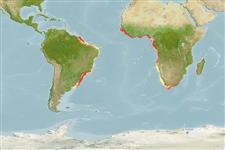>
Perciformes/Bembropoidei (Duckbill flatheads) >
Bembropidae (Duckbill flatheads)
Etymology: Bembrops: Greek, bembras, -ados = a kind of anchovy m+ Greek, ops = appearance (Ref. 45335); heterurus: Specific name probably from the Greek 'heteros' meaning different and 'oura' meaning tail..
Environment: milieu / climate zone / depth range / distribution range
Ecología
marino demersal; rango de profundidad 50 - 400 m (Ref. 6948), usually 80 - 200 m (Ref. 47377). Deep-water; 12°N -
Western Atlantic: off Rio de Janeiro, Brazil to Uruguay. Eastern Atlantic: Mauritania to the extreme northern waters of Namibia (Ref. 6948, 27121). The eastern Atlantic form referred to as Bembrops heterurus is unlikely to be conspecific with the Brazilian form, thus further taxonomic study is needed to clarify this situation (Ref. 6948).
Tamaño / Peso / Age
Maturity: Lm ? range ? - ? cm
Max length : 28.0 cm TL macho / no sexado; (Ref. 6948); common length : 20.0 cm TL macho / no sexado; (Ref. 2683)
Espinas dorsales (total): 6; Radios blandos dorsales (total): 14-15; Radios blandos anales: 16 - 18. Color in alcohol light yellowish to yellowish brown dorsally, light yellowish brown to creamy brown ventrally. Upper lobe of caudal fin elongated at an acute angle. Snout relatively short, 1.0-1.4x eye diameter. Scales on lateral and dorsal surfaces of snout including area in front of eye. Upper jaw extending behind anterior margin of eye but not reaching its mid-line. Maxillary tentacle short. Lateral line descending gradually along dorsal edge of pectoral fin, separated from origin of first dorsal fin by 4 or 5 rows of scales, from origin of anal fin by 6 or 7, and from insertion of anal fin by 3-5. Pectoral fin moderately rounded. Lower lobe truncate or rounded (Ref 13203).
Found on soft bottoms of the continental shelf and feeds on crustaceans and fishes (Ref. 3656).
Life cycle and mating behavior
Madurez | Reproducción | Puesta | Huevos | Fecundidad | Larva
Das, M.K. and J.S. Nelson, 1996. Revision of the percophid genus Bembrops (Actinopterygii: Perciformes). Bull. Mar. Sci. 59(1):9-44. (Ref. 13203)
IUCN Red List Status (Ref. 130435)
Threat to humans
Harmless
Human uses
Pesquerías: comercial
Más información
ReferenciasAcuiculturaPerfil de acuiculturaRazasGenéticaElectrophoresesheritabilidadEnfermedadesProcesamientoNutrientsMass conversion
ColaboradoresImágenesStamps, Coins Misc.SonidosCiguateraVelocidadTipo de nataciónSuperficie branquialOtolitosCerebrosVisión
Herramientas
Special reports
Download XML
Fuentes de Internet
Estimates based on models
Preferred temperature (Ref.
123201): 13.9 - 24.3, mean 16.8 °C (based on 91 cells).
Phylogenetic diversity index (Ref.
82804): PD
50 = 0.5000 [Uniqueness, from 0.5 = low to 2.0 = high].
Bayesian length-weight: a=0.00447 (0.00244 - 0.00818), b=3.08 (2.92 - 3.24), in cm total length, based on LWR estimates for this species & (Sub)family-body (Ref.
93245).
Nivel trófico (Ref.
69278): 4.0 ±0.2 se; based on diet studies.
Fishing Vulnerability (Ref.
59153): Low vulnerability (18 of 100).
Nutrients (Ref.
124155): Calcium = 39.5 [22.6, 86.9] mg/100g; Iron = 0.449 [0.208, 0.883] mg/100g; Protein = 17.6 [16.5, 18.5] %; Omega3 = 0.278 [0.133, 0.571] g/100g; Selenium = 15.6 [6.0, 36.2] μg/100g; VitaminA = 13.8 [2.9, 63.8] μg/100g; Zinc = 0.446 [0.301, 0.661] mg/100g (wet weight);
